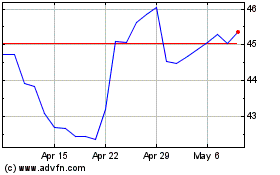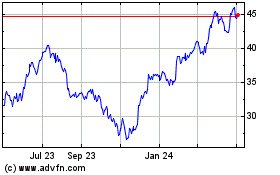By Mike Colias and Nora Naughton
Contract talks between General Motors Co. and the United Auto
Workers appeared headed into the weekend, with each side accusing
the other of bogging down negotiations to end a nearly month-long
strike.
In dueling public statements late this week, the company and
union each pointed a finger at the other for not working diligently
enough to reach a new four-year contract and put 46,000 full-time
factory employees back to work.
The escalation came shortly after GM Chief Executive Mary Barra
and UAW President Gary Jones met Wednesday for the first time since
the strike began, in an effort to break the impasse.
On Friday morning, GM -- frustrated at the pace of negotiations
with the United Auto Workers -- appealed directly to factory
workers with details of its latest contract proposal. The letter,
to all U.S. employees from GM's global manufacturing chief, Gerald
Johnson, outlined broad terms of the company's latest offer --
including new details that haven't been made public before, such as
a clear path to full-time status for temporary workers.
Mr. Johnson said the proposal also includes pay increases
through wages and lump-sum payments in each of the contract's four
years, as well as improved yearly profit-sharing payouts for hourly
workers and no increase in out-of-pocket health care costs.
The UAW responded with a sharply worded statement later Friday,
claiming GM is to blame for the stalled negotiations and its
members are ready to get back to work.
It accused GM of issuing "half truths" about its offer and
prolonging talks to put pressure on workers to accept a
less-than-attractive deal that preserves corporate wealth.
"The company's strategy from day one has been to play games at
the expense of the workers," the UAW said.
GM, in making its offer public, is taking the unusual step of
appealing directly to rank-and-file workers, a move that is without
precedent in previous years of contract talks.
Historically, bargaining has largely taken place behind closed
doors, with both union and company negotiators avoiding public
commentary, particularly in the media, until a contract deal is
reached.
GM workers have been on strike since mid-September, idling more
than 30 U.S. factories and triggering shutdowns of GM plants in
Canada and Mexico. The lost production and other disruption from
the work stoppage has cost GM roughly $1.5 billion so far,
according to an estimate Friday from Credit Suisse analyst Dan
Levy.
In its latest offer to the union, GM said it would boost the
planned investment in U.S. facilities to roughly $9 billion, up
from the $7 billion in an earlier proposal made public just before
the strike began, according to a person familiar with the
proposal.
This week, the UAW said it is pressing GM for better job
security by making a firmer commitment to build more cars and
create jobs in the U.S.
In an internal back-and-forth between the UAW and GM Thursday
night, the company expressed frustration that UAW bargainers hadn't
responded to GM's latest proposal, which it put forward Monday. The
UAW said it would wait until several bargaining subcommittees
conclude their analysis before formally responding.
Shortly after the strike was announced, GM publicized the
details of its original offer in a statement to the press, angering
UAW officials, people familiar with the matter said. Since then,
the UAW has put out several letters to its members and publicly
criticized aspects of GM's proposals, while GM had largely stayed
quiet, until Friday's letter.
Negotiators during collective bargaining generally don't go
public with details of terms being discussed at the table, said Art
Schwartz, a former GM labor negotiator who now works as a
consultant.
"Usually you don't like to bargain in the press, because you're
putting the other side on the spot and it becomes a war of words
instead of getting work done," Mr. Schwartz said.
Mr. Johnson's letter indicates that since the strike took
effect, GM has moved closer to the union's demands, including a
path to full-time work for temporary employees, which had been a
sticking point. The sides have made progress on several economic
issues such as pay increases and the wage scale for new hires,
people close to the talks have said.
Still, union leaders said this week they don't think GM has done
enough to guarantee job security over the next four-year contract,
claiming the company needs to offer assurances it will fully fill
its U.S. factories before building cars in foreign markets like
Mexico for import to the U.S.
UAW officials and members entered talks still angry over GM's
move last November to close four underused U.S. factories.
"Economic gains in this agreement will mean nothing without job
security, " UAW Vice President Terry Dittes wrote in a letter to
union members Tuesday.
A week ago, both sides signaled hope that a deal was within
reach, but negotiations stalled Sunday, prompting the UAW to
release a sharply worded letter expressing disappointment in GM's
position. That led to GM's fresh offer Monday.
By Wednesday, GM executives had grown increasingly irritated
that the union hadn't yet responded, people familiar with the
matter said. That prompted Chief Executive Mary Barra to request a
meeting with UAW President Gary Jones. The roughly 45-minute
meeting between the executives and top negotiators Wednesday was
productive but didn't lead to any breakthroughs, people briefed on
the meeting said.
Mr. Schwartz said it would be unusual for a proposal to go
unanswered for several days during late-stage negotiations,
especially during a strike. "That response normally should come
within hours," he said. "I think what you're seeing here is a
little bit of frustration from GM."
UAW workers will miss their third weekly paycheck on Friday.
They are receiving weekly $250 payments from the union's strike
fund to ease the impact, although that represents a fraction of
their normal take-home pay.
Liz Hoople, an assembly-line worker at a GM factory in Lansing,
Mich., said she set aside money to weather a strike. Still, she
recently postponed some landscaping work and bathed her two dogs at
home, rather than spending the usual $100 at the groomer.
"Nobody wants this to go on longer than necessary," said Ms.
Hoople, 50 years old. "But people are willing to stay out as long
as they can to see some drastic change."
Write to Mike Colias at Mike.Colias@wsj.com
(END) Dow Jones Newswires
October 11, 2019 14:59 ET (18:59 GMT)
Copyright (c) 2019 Dow Jones & Company, Inc.
General Motors (NYSE:GM)
Historical Stock Chart
From Mar 2024 to Apr 2024

General Motors (NYSE:GM)
Historical Stock Chart
From Apr 2023 to Apr 2024
